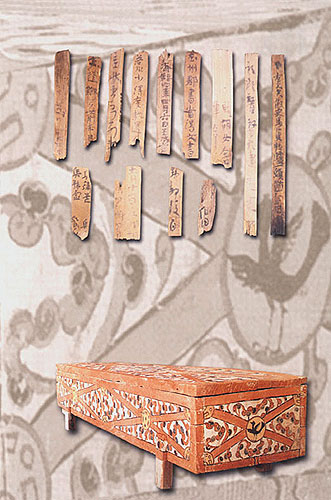| Art Q&A > Archeology |
|
|
City Site in State of Loulan
An ancient city of State of Loulan of the Han Dynasty (206BC-220AD)
Location: Ruoqiang County, Xinjiang Uygur Autonomous Region
Period: 3rd century-4th century
Excavated in 1900
Significance: It has supplied precious materials to the study of the relationships between the empire located in the Central Plains and ancient kingdoms in the Western Regions, which covers the area of the present-day Xinjiang and parts of Central Asia. It is also of great importance to the study of the cultural exchanges between the East and the West, as well as the Silk Road.
On the west bank of Lop Nur Lake, which is now a lake of sand instead of
water, the Ancient City of Loulan was founded in the 2nd century BC in an oasis
with rich water network. However it suddenly waned into the history after about
800 years flourish. The city, once the capital of Loulan State which was one of the 36 Western Regions
states, occupied very significant position on the Silk
Road; however it simply vanished, the only recognizable
structures are a pagoda which is the largest structure in the ruins, and a
seems-to-be office which still has painted timber traces.
At the beginning of last century, a Swedish explorer in his exploration accidentally discovered the city, which covers an area of about 100,000 square meters, buried in desert. The discovery startled the world. The city is in the shape of irregular square, with the east city wall of 333 meters, the south wall of 329 meters, and the west and north walls respectively 327 meters.
Archeologists believe there was once a water tunnel running through the city and dividing it into two functional parts. Large amounts of potsherds, wood pieces, coins, jewelries and wood slip documents are listed in the archaeological finds, which provide us many clues of the ancient city.
In recent years, there were greater finds around the ruins. Archaeologists found the graveyard which was lost after its previous discovery. On a giant sand dune, there are densely distributed wood stakes which are apparently arrayed around a column like genital. Hundreds of cymbiform coffins scatter around, while most of them are broken, with mummies lying around. Among one of them, one coffin contains a well-preserved mummy who is female with Caucasian features. Archaeologists also found colorfully painted and crosshatched coffins, remaining new. A real size wood statue with clear female characteristics, though cracking and crippled, proves that early Loulan people could produce fairly good artistic pieces. The graveyard is, archaeologists believe, a holy place where early Loulan people prayed for strong reproductive ability.
The discovery may explain why the active and flourishing oasis vanished. It is discovered early Loulan people preferred Sun Tomb, consisting of seven circles of logs, which become thicker and thicker from the center to the outer circle radiating like the sun. The unique and spectacular burying form prevailed and undermined Loulan's existence. Large amount of trees was consumed before Loulan people realized and legislated to control wood consumption and to protect woods and trees. However it seemed to be late and the city swallowed by the fierce desert. |
||||
All rights reserved. Reproduction of text for non-commercial purposes is permitted provided that both the source and author are acknowledged and a notifying email is sent to us. |
||||
 |
 Introduction
Introduction
 History
History